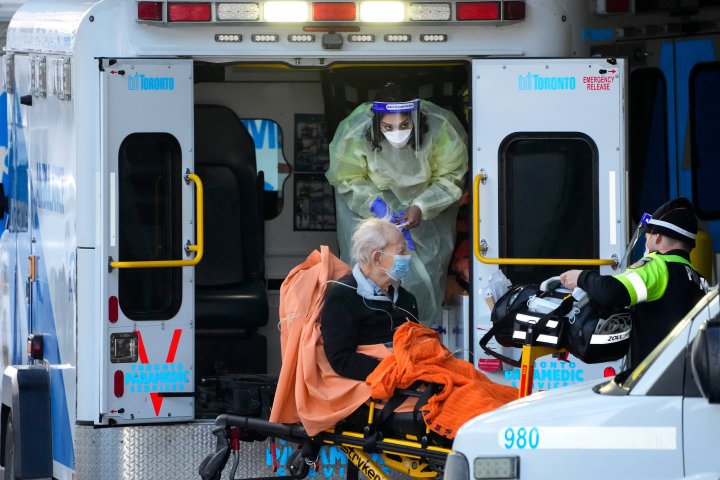COVID-19 hospitalizations, cases continue to rise in most provinces amid 6th wave

COVID-19 hospitalizations and cases are on the rise once again across Canada, according to public health data, as the reality of a sixth wave of the pandemic begins to take shape.
As of Monday, the seven-day average of daily lab-confirmed cases sits just above 9,843, a nearly 50 per cent jump from just two weeks prior.
Hospitalizations are also rising, with 4,876 people currently receiving care, up 17 per cent since last week and about 30 per cent above the number two weeks ago. Of those patients, 394 are in intensive care, a slight uptick since late March.
Although every province except Ontario and Quebec has moved from reporting COVID-19 data daily to now posting weekly updates, a majority of jurisdictions in Canada is seeing a rise compared to last month.
Canada’s chief public health officer Dr. Theresa Tam and her provincial counterparts have said an even more transmissible subvariant of Omicron, dubbed BA.2, is behind the current wave.
Ontario and Quebec have both seen cases rise between 10 and 20 per cent over the past week, while hospitalizations are up around 30 per cent in both provinces.
Yet provincial officials, who have approved the lifting of nearly all public health measures brought in to combat previous waves, have said they will not reimpose those restrictions even as cases and hospitalizations surge.
In his first press conference in nearly five weeks, Ontario’s chief medical officer of health Dr. Kieran Moore said Monday the province will not bring back its mask mandate, despite public health indicators worsening.
Moore said he strongly recommends people continue to wear masks in indoor public spaces, and urged residents to get their booster doses, because they are helping to keep people out of hospital when infected.
Quebec’s interim public health director Dr. Luc Boileau told reporters Friday that the province remains in a “fragile situation” amid recent projections that hospitalizations will continue to rise over the next two weeks.
“We can’t forget the virus is present and the pandemic isn’t over,” he said.
The province made the rare step last week of maintaining its indoor mask mandate in place until at least the end of April, which officials said would help prevent the health-care system from being overwhelmed. Only Prince Edward Island has taken a similar step.
Comparing the most recent weekly reports to the previous week’s data, only British Columbia, Newfoundland and Labrador and Saskatchewan are seeing steady or declining cases and hospitalizations.
Yet experts in some of those provinces say that may soon change. Modellers in British Columbia predict the province could soon see a rise in cases and hospitalizations similar to what’s occurring now in eastern Canada.
Tam said on April 1 that Canadians should make their own decisions on how to protect themselves from the latest wave based on their personal health, as well as the setting they are in and the amount of transmission in their community.
She said Canadians should keep wearing face coverings and ensure vaccinations are up to date amid rising case counts and reduced public health measures.
“I think the bottom line is everybody right now should still wear that mask and keep those layers of measures, no matter where you are in this country,” she said.
Provinces are continuing to allow more people — primarily older Canadians and those at risk of severe infection — to get a fourth vaccine dose as a second immunity booster.
Saskatchewan on Monday became the latest province to expand eligibility, offering the shot to those over 70 and Indigenous people over 50.
Ontario is allowing fourth doses to those over the age of 60 as of last week. The province on Monday expanded access to PCR testing and antiviral treatments, like Pfizer’s Paxlovid pill, to those over 70 and younger residents who have not been boosted with a third dose.
Yet less Canadians are getting just one booster, and there are signs that the program is stalling at the same rate as the initial vaccination campaign.
About 47 per cent of all Canadians have received a third dose, according to federal data. By contrast, 82 per cent of the population is considered fully vaccinated with two doses.
Both figures have grown at a rate of just one per cent over the past month.
Over the last several weeks, Tam has suggested Canada is in a “period of uncertainty,” and has emphatically advocated for people to get up to date on their vaccinations to protect themselves against severe disease.
She warned on April 1 that this uncertainty might lead to further waves of COVID-19 cases this year.
“We anticipate that progress will not be linear, and there will likely be more bumps along the way, including resurgence in cases this spring, and likely also in the fall and winter,” she told a news briefing.
–With files from the Canadian Press
by Global News







